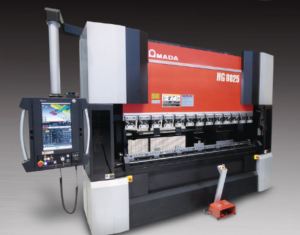Article Revised August 28th, 2022

Press braking and roll forming are both types of metal bending and forming, but though they both fall under the same basic process type, they have little else in common. While both are important, each has distinct advantages and disadvantages, and their appropriate use depends on the end product being fabricated. This week, we’ll take a closer look at press braking, and you can come back next week to see how it compares to roll forming.
Press Braking Advantages
Press braking is one of the most common forms of metal bending due to its general cost-effectiveness and efficiency compared to the other available options. Press brakes have a faster, easier setup process, contributing to their comparatively low cost. In general, press breaking is considered the least expensive of the bending processes, and it is an incredibly useful and integral facet of most full-service metal fabrication companies.
Press Braking Disadvantages
Although we often utilize press brakes for fabrication, there are times when it’s simply not the right process for a given job. Press braking is best for small-to-medium part volumes, so it is usually not a great choice for fabricators specializing in large production runs of a single product. The exception to this rule is when press braking is automated via robots, in which case, even very large production runs are possible. One reason EVS uses press braking quite frequently is that we often work with clients who require short runs, or even prototypes of various products, in what’s considered a high-mix, low-volume production environment. Therefore, press braking is usually our go-to bending process.
Looking for precision sheet metal fabrication and machining services?

Press brakes also cannot make bends for parts longer than a typical bed length (at EVS, that would be 10’, but there are beds as long as 12’). Longer part lengths would generally go through the roll forming or stamping process instead. In addition, exceptionally tight tolerances, i.e., those of less than +/-.005, are generally not ideal candidates for press braking. Finally, metal items that have undergone the press braking process will not look as immediately “finished” as parts bent in other ways, such as via roll forming. This means the product may require a secondary finishing process such as painting, powder coating, or polishing if it is sold as a stand-alone item instead of integrated into a larger product.
Press Braking: A Fabrication Workhorse
With only a handful of exceptions, modern press braking is a fabricator’s best friend. It’s often the best bending option in low-volume, high-mix environments like that found at EVS Metal.
EVS Metal is an ISO 9001:2015-certified leader in quality precision sheet metal fabrication with four locations across the U.S. Our stainless steel and aluminum manufacturing capabilities expand far beyond traditional fabrication practices in order to provide clients with a distinct competitive advantage — the option to utilize EVS’ comprehensive range of in-house manufacturing solutions, including forming multiple forming solutions.
Whether our clients require product design and engineering, machining, powder coat finishing, or assembly and integration, our team of experts delivers quality outcomes that meet our customers’ requirements and exceed their expectations. We guarantee that each job will produce superior products at highly competitive prices for every order, no matter the size. For more information or to request a quote, contact EVS Metal today.





